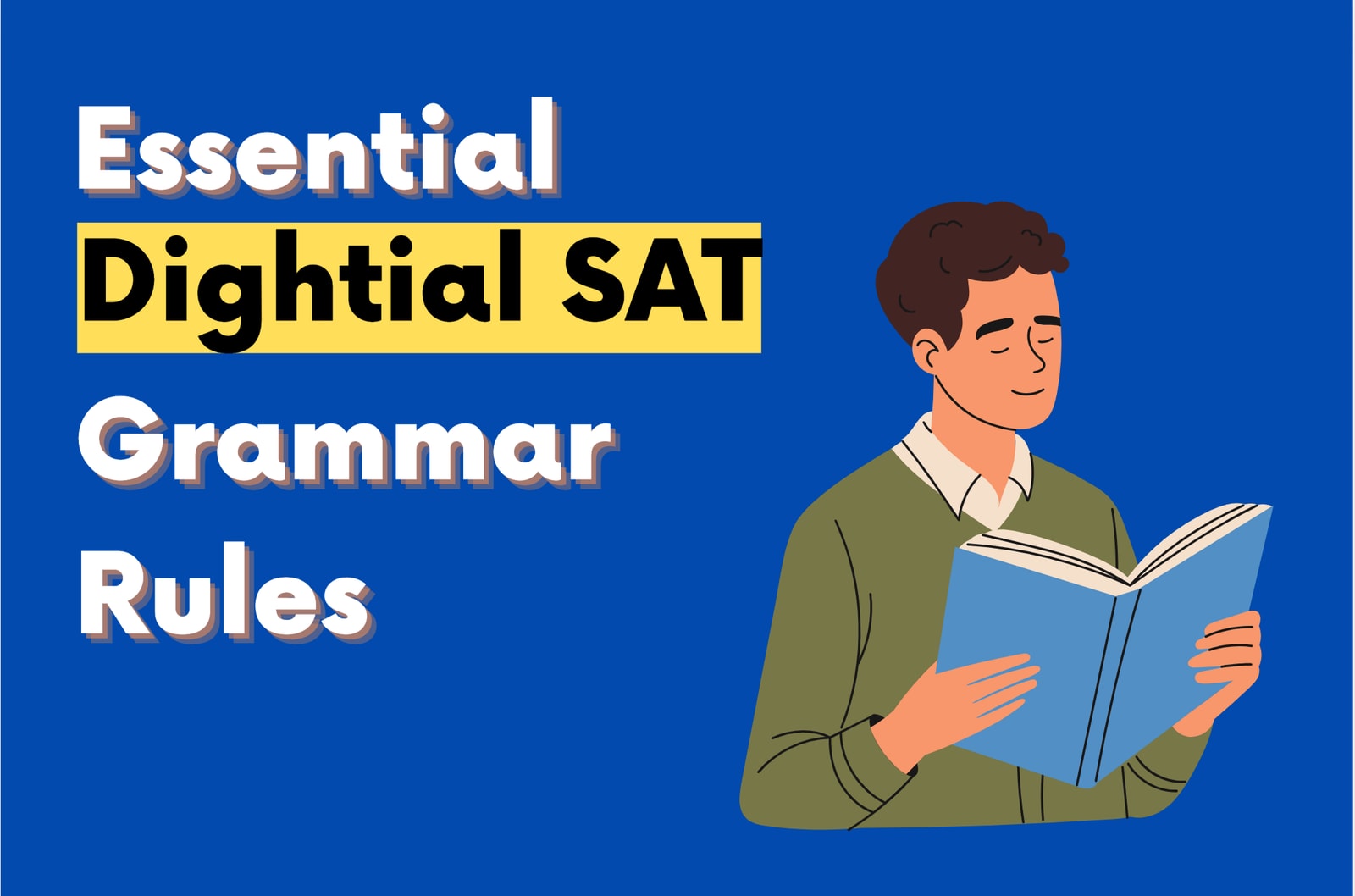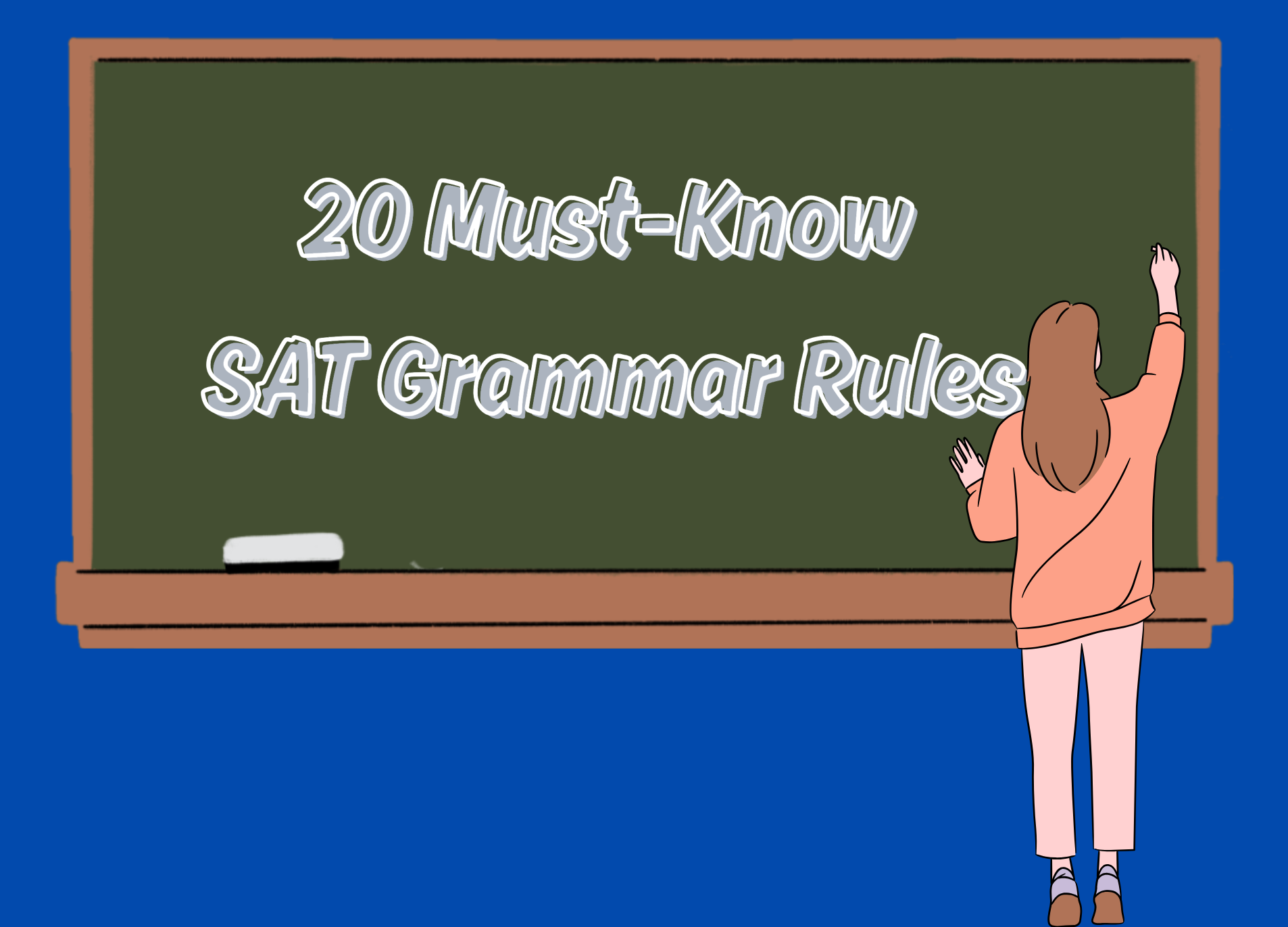Essential SAT Grammar Rules Handout
Author
Phoenix Wilder
Date Published

Mastery of grammar principles is essential to performing well on the SAT. From writing and language sections to reading comprehension, your knowledge of standard English conventions is continuously assessed. Understanding these frequently tested grammar rules will help you not only answer grammar-based questions with confidence, but also free up valuable time to tackle more complex sections. In this guide, we’ll explore the fundamental SAT grammar rules—each explained in detail and accompanied by illustrative examples—so you can maximize your test-day score.
Why Grammar Is Important on the SAT
Solid grammar skills are at the heart of the SAT’s writing and language section, where you’ll analyze passages for errors and select the best revisions from multiple-choice options. This is not just about identifying obvious mistakes—many questions are designed to be subtle and test nuanced aspects of grammatical convention.
Some students make the mistake of focusing all their attention on “big picture” reading comprehension or mathematical reasoning, only to lose critical points over slipups in sentence structure, punctuation, or proper word usage. With the SAT’s strict time limits, the ability to quickly spot and address grammar issues will help you breeze through writing questions and focus precious time on challenging reading analysis.
Good grammar is also broadly interdisciplinary. The writing sections might reference topics in science, literature, history, and social studies. If you can quickly and accurately read and revise the passages, you’ll have more time to reflect on each question and reason your choices thoroughly.
How (and When) to Prepare
Preparation for the SAT generally begins in your junior year of high school, as coursework and prior reading experience provide the foundation upon which SAT-specific grammar is built. If you find that your readiness quizzes or practice exams aren’t producing satisfactory results, don’t worry—there are ample study resources and expert tutoring options available to help you close the gap, particularly when it comes to grammar conventions.
15 Essential SAT Grammar Rules
Let’s break down the fundamental grammar rules you need to ace the SAT:
1. Distinguishing Possessive vs. Plural Nouns
One of the most common sources of error on the SAT is confusing possessive and plural forms, especially when it comes to apostrophe use.
· Possessive nouns: add an apostrophe and “s” (or just an apostrophe for plural possessive).
Example: The dog's bowl (possessive — the bowl belongs to the dog)
· Plural nouns: add “s” without an apostrophe.
Example: The dogs (plural — more than one dog)
Be on guard: Personal pronouns follow a different rule. Possessive pronouns do not use apostrophes:
· its, hers, his, theirs, mine, ours, yours
Apostrophes with pronouns signal contractions:
· He’s = he is, It’s = it is, She’s = she is
Examples:
· Correct: The dog's bowl (possessive) vs. The dogs (plural)
· Incorrect: The dog's (plural) vs. The dogs' (possessive in the wrong context)
2. Pronoun-Antecedent Agreement
Pronouns must match their antecedents in number and gender. The SAT may intentionally use sentences that violate this rule:
· Incorrect: If Julia wants to keep healthy, they should eat broccoli.
· Correct: If Julia wants to keep healthy, she should eat broccoli.
Also, collective nouns (like “team”) can be singular or plural, but are usually treated as singular when referring to the group as one unit.
· Correct: The team won its first game.
3. Consistent Verb Tense
Shifting verb tense without clear purpose confuses meaning. Narratives should stick to a consistent tense:
· Incorrect: I take Dalia to the pub. We ate calamari and drank cider.
· Correct: I take Dalia to the pub. We eat calamari and drink cider.
4. Avoid Sentence Fragments
A sentence fragment does not express a complete thought. They usually lack a subject or a complete verb.
· Fragment: Michael took a flight to London. And then a train to Paris.
· Correct: Michael took a flight to London and then a train to Paris.
Verb fragments also make sentences incomplete:
· Fragment: Michael becomes.
· Correction: Michael becomes excited when he travels.
5. Subject-Verb Agreement
Singular subjects require singular verbs; plural subjects require plural verbs. Irregular verbs can make this tricky.
· Incorrect: The girls runs back to the apartment.
· Correct: The girls run back to the apartment.
Irregular examples:
· Singular: is/was, does/did, has/had, goes/went
· Plural: are/were, do/did, have/had, go/went
6. Using “Who” vs. “Whom”
“Who” functions as a subject; “whom” as an object. “Whom” often follows a preposition.
· Correct: Who is that? vs. To whom should I address this letter?
7. Avoid Unnecessary Commas (Comma Splices)
Do not use a comma to join independent clauses without a conjunction.
· Incorrect: My wife and I drove to see her parents’ house, her mother and father weren’t home.
· Correct:
My wife and I drove to her parents’ house. They weren’t home.
My wife and I drove to her parents’ house, but they weren’t home.
My wife and I drove to her parents’ house; they weren’t home.
8. Do Not Omit Necessary Commas
Use a comma to join independent clauses with a coordinating conjunction, or after introductory clauses.
· Incorrect: Michael took a flight to London and then a train to Paris.
· Correct: Michael took a flight to London, and then a train to Paris.
Introductory clause:
· Correct: Since everyone else wants to go out in this rainy weather, I’ll just stay home alone.
9. Correct Dangling Modifiers
Modifiers must clearly relate to the subject. A dangling modifier creates confusion.
· Incorrect: After a long day at the office, Julia’s dog still wanted to play.
· Correct: After a long day at the office, Julia came home to find that her dog wanted to play.
10. Word Choice Matters
The SAT will try to trick you with lookalike or soundalike words. Know the difference:
· Affect (verb) vs. Effect (noun)
· Than (comparison) vs. Then (sequence)
· Allusion (reference) vs. Illusion (deception)
· Elicit (verb: evoke) vs. Illicit (adjective: illegal)
· Anyway (correct: digression) vs. Anyways (incorrect)
Examples:
· The effect of climate change vs. He will effect change.
11. Use Periods & Semicolons Wisely
Periods end sentences. Semicolons join closely related independent clauses.
· London is an old city. It has been inhabited for around 2,000 years.
· London is an old city; it has many new buildings.
· London is an old city; however, it has many new buildings.
Avoid:
· London is an old city; and it has many new buildings. (Don’t put a semicolon before a coordinating conjunction)
12. Colons and Dashes for Emphasis
Use colons after a complete sentence to introduce a list or explanation. Deploy dashes for dramatic emphasis or interruption.
· Correct: Visitors to London often spend their time in three main types of attractions: museums, castles, and shops.
· Correct: The Manchus took control of China, the Great Wall lost its protective purpose—the Chinese empire now extended well north of the wall.
Avoid:
· London is home to a variety of: museums, castles, and shops.
13. Commas and FANBOYS
A comma is mandatory before a coordinating conjunction (for, and, nor, but, or, yet, so) that links two independent clauses.
· London is a very old city, but some parts of it are modern.
· London is a very old city, and it is very appealing to tourists.
Incorrect: London is a very old city, it has some extremely modern parts. (comma splice)
14. Commas for Dependent Clauses
When a sentence begins with a dependent clause, follow it with a comma.
· Because London is a very old city, it has buildings from many different eras.
· Although London is a very old city, it has many modern buildings.
15. Smooth Transitions
Transitional words (“however,” “therefore,” “moreover”) clarify relationships between ideas.
· Correct: The obvious reason for building the Great Wall of China was protection. However, China had no powerful enemies when the Wall began.
· Incorrect: The obvious reason... was protection, China had no powerful enemies when the Wall began to be built. (comma splice)
Frequently Asked Questions
How can I spot grammar mistakes on the SAT?
Trust your ear—read sentences aloud (even quietly) to catch awkward constructions. If something sounds unnatural, read it carefully several more times, then analyze the suspect sections for subject-verb agreement, pronoun reference, or other common issues.
How many conventions do I need to know?
Focus on mastering these core 10–15 conventions. The SAT tends to repeat its grammar “traps,” so thorough understanding of these areas is better than a shallow knowledge of many rare rules.
What if I get stuck on a question?
Break down the sentence: underline subjects, verbs, and pronouns to clarify relationships, particularly if confusing prepositional phrases try to distract you from the main clause.
Any tips for guessing?
The most concise, straightforward answer is often correct on grammar questions. Eliminate answer choices that “add” unnecessary words or complicated constructions.
Where can I find more resources?
In addition to personalized one-on-one tutoring, using specialized online platforms can greatly enhance your SAT preparation. For example, Best SAT Score offers adaptive full-length SAT practice tests, allowing you to simulate real exam conditions and identify areas that need improvement. The platform also generates personalized study plans based on your performance, helping you focus your efforts and maximize your score gains. Utilizing intelligent tools like these can make your study process more efficient and effective.
Conclusion
Acing the SAT writing and language section is within reach—with systematic review and practice of these grammar conventions. Take time to internalize each rule, practice with sample passages, and you’ll build confidence and efficiency for test day. Meticulous grammar skills are not just for the SAT but will benefit your command of written English for years to come.
Related Posts

Prepare for the SAT with 20 key grammar rules every test-taker should know. Improve accuracy, avoid common traps, and score higher!

Discover what’s tested on the SAT Writing section, including key grammar rules, question types, and tips to boost your score.